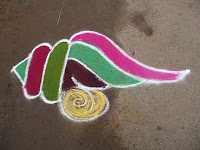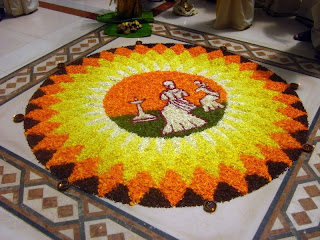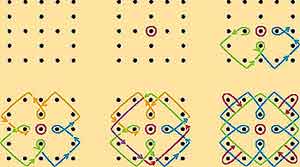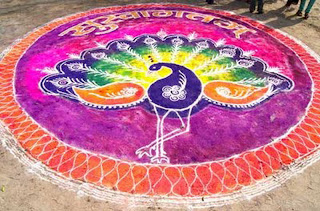First of all HAPPY DIWALI to all of you...here is some Rangoli designs...

'Rangoli' is a Sanskrit word which means a creative expression of art through the use of color.

The word rangoli may also have come from "rang" (color) + "aavalli" (row), which means row of colors, or from rang+avalli, which means creepers of colors. Basically, Rangoli is the art of drawing images and motifs on the floor and walls of one's home using different color powders. Designed with a beautiful combination of various colors, the Rangoli images create an enchanting piece of art. Basically a floor painting, a rangoli image stands for a sign of welcome. The main purpose of making rangolis in diwali is to welcome Goddess Laxmi, the Goddess of wealth to individual homes apart from warding off the evil eye. The art of rangoli is known by different names in different regions such as "Rangoli" in Maharashtra, Alpana (in Bengal), and Kolam (in South India). Although Rangoli has its origins in Maharashtra, today it is practiced everywhere. One of the most popular arts among Indian women, rangoli is an age old custom of India, and practiced all over the country.

-
The Rangoli designs are passed down through generations, with some of them being hundreds of years old. Though the designs vary in different sections of India, the basic approach is common. The designs are geometric and proportioned. It has been a tradition in culturally rich India to draw Rangoli on the festivals and other auspicious occasions as it is considered a holy ritual. There is a unique relationship between the festival of diwali and rangoli. Diwali is a major festival of India and drawing rangoli on diwali is a part of diwali celebrations.
The patterns are made with finger using rice powder, crushed lime stone, or colored chalk. They may be topped with grains, pulses, beads, or flowers. Since the entire objective of making rangoli in diwali is to welcome Goddess Laxmi, small footprints coming into the home, representing the footprints of the Goddess, are also made. Rangolis can be of any size, from the size of a doormat, to the covering an entire room. Though making of a Rangoli is highly dependent on the preferences and skills of the maker, lines are always drawn on one finger movement (rangolis are always drawn with fingers) and frequently, the mapping of the rangoli is done with the help of dots, which are joined to form a pattern, and then the pattern is filled with colors.
 one important point is that the entire pattern must be an unbroken line, with no gaps to be left anywhere, for evil spirits are believed to enter through such gaps, if they find one. In an expert hand, the images created are elaborate and look as if they are painted. In India, this art is temporary. Each rangoli design generally stays for only a day or two as it is often redone as a part of the daily routine. Certain designs are created on special occasions such as weddings and religious festivals like Diwali.
one important point is that the entire pattern must be an unbroken line, with no gaps to be left anywhere, for evil spirits are believed to enter through such gaps, if they find one. In an expert hand, the images created are elaborate and look as if they are painted. In India, this art is temporary. Each rangoli design generally stays for only a day or two as it is often redone as a part of the daily routine. Certain designs are created on special occasions such as weddings and religious festivals like Diwali.Rangoli Decoration Themes
Rangoli designs are generally based on themes that have been in use through ages. The common rangoli themes are the celestial symbols such as the rising sun, moon, stars, zodiac signs, holy symbols like Om, mangal kalash, swastika, chakra, a lighted Deepak, trident, "shree", lotus etc.

Goddess Lakshmi in the lotus symbolizes the figure of renewed life. Other popular themes are natural images like flowers, creepers, trees, fish, birds, elephants, dancing figures, human figures and geometrical figures such as circles, semi-circles, triangles, squares and rectangles. Drawing Diwali rangoli at the
 entrance door of individual homes is the common sight during Diwali decoration. For this, the footsteps of Goddess Lakshmi entering into the home are designed at the main entrance of the home or near the place of worship, which indicates the entrance of prosperity in the home. This is the special Diwali rangoli for the entrance. It is considered auspicious as it signifies showering of good luck and prosperity on the house and in the family.
entrance door of individual homes is the common sight during Diwali decoration. For this, the footsteps of Goddess Lakshmi entering into the home are designed at the main entrance of the home or near the place of worship, which indicates the entrance of prosperity in the home. This is the special Diwali rangoli for the entrance. It is considered auspicious as it signifies showering of good luck and prosperity on the house and in the family.However, all said and done, the theme and design of a Diwali Rangoli is dependent upon the creativity and
 imagination of an individual. Rangoli can be improvised into diverse visual art forms. There is really no limit to what you can do with a Rangoli. Because of this aspect of Rangoli, some Hindu communities in India actually organize Rangoli competitions during Diwali celebrations and prizes are given for the best designs. It is a delight to see the colorful designs unfold in the lights and fireworks of Diwali.
imagination of an individual. Rangoli can be improvised into diverse visual art forms. There is really no limit to what you can do with a Rangoli. Because of this aspect of Rangoli, some Hindu communities in India actually organize Rangoli competitions during Diwali celebrations and prizes are given for the best designs. It is a delight to see the colorful designs unfold in the lights and fireworks of Diwali.Rangoli Ingredients
A
 variety of ingredients are used to create a Rangoli. In old days, the colors were traditionally derived from natural dyes - from barks of trees, leaves, indigo, etc. Today however, synthetic dyes are used in a range of bright hue. Rangoli being mainly a floor art, powdered colors are used on cleaned floors to form decorations. The powder primarily consists of finely grounded rice flour. Finely ground white stone powder is used these days, as this is easier to apply and makes the rangolis brighter and well finished. One can also mix rice flour with white stone powder for a better preparation. The powder is usually taken in a pinch and applied with the thumb and the forefinger. Rangolis can be vivid, three-dimensional art complete with shadings when cereals, pulses either in their natural coloring or tinted with natural dyes are applied or they can be the traditional plain, yet as beautiful as, two-dimensional designs when colored powder such as rice, brick, chilly, turmeric, etc is used. In south Indian states like Kerala, flowers like marigolds and chrysanthemums and leaves are used to create Rangoli.
variety of ingredients are used to create a Rangoli. In old days, the colors were traditionally derived from natural dyes - from barks of trees, leaves, indigo, etc. Today however, synthetic dyes are used in a range of bright hue. Rangoli being mainly a floor art, powdered colors are used on cleaned floors to form decorations. The powder primarily consists of finely grounded rice flour. Finely ground white stone powder is used these days, as this is easier to apply and makes the rangolis brighter and well finished. One can also mix rice flour with white stone powder for a better preparation. The powder is usually taken in a pinch and applied with the thumb and the forefinger. Rangolis can be vivid, three-dimensional art complete with shadings when cereals, pulses either in their natural coloring or tinted with natural dyes are applied or they can be the traditional plain, yet as beautiful as, two-dimensional designs when colored powder such as rice, brick, chilly, turmeric, etc is used. In south Indian states like Kerala, flowers like marigolds and chrysanthemums and leaves are used to create Rangoli.As a Rangoli is created through sprinkling powder by hand it is a very laborious and difficult process, and it's
 difficult to render fine details - meaning the image must be quite large. But all pains are taken to create a perfect Rangoli. Why? Because this art reflects the Indian culture and upholds the age old values of hospitality, perfection in art and also, a deep-rooted reverence for the divine beings and a fear for the powers beyond the realm of human understanding.
difficult to render fine details - meaning the image must be quite large. But all pains are taken to create a perfect Rangoli. Why? Because this art reflects the Indian culture and upholds the age old values of hospitality, perfection in art and also, a deep-rooted reverence for the divine beings and a fear for the powers beyond the realm of human understanding.Rangoli brings a sense of completion in the joyous celebrations of Diwali.
I arranged few rangoli designs frm google also..




Pinx...
